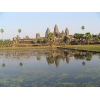|
 The history of Cambodia is very sad. The prosperity of ancient Khmer civilization of VIII - XII centuries was followed by centuries of endless wars and deep misery. The calamity reached its apogee in the XX century during the Khmer Rouge regime under Pol Pot when every forth citizen of Cambodia died from execution or starvation.
The history of Cambodia is very sad. The prosperity of ancient Khmer civilization of VIII - XII centuries was followed by centuries of endless wars and deep misery. The calamity reached its apogee in the XX century during the Khmer Rouge regime under Pol Pot when every forth citizen of Cambodia died from execution or starvation.
Cambodians seem not to be able to realize the
value of their inheritance. Therefore, they continue slowly to plunder
Khmer temples and sell unique sculptures and bas-reliefs for next to
nothing. Local residents are very good-natured and treat their guests
with a big sympathy.
The city in the jungle
Hundreds of years ago Angkor, the capital of the ancient Khmer state,
was one of the largest and most beautiful cities in the world with a
territory of 250 sq. miles! Twenty six Khmer kings had built it for six
centuries in the wilderness of the jungle. The scale of construction
can be compared with the Pyramid construction in Egypt. In the XV
century in the course of the war with Thailand, Angkor was ruined and
abandoned. The unique city was neglected for 400 years. Just in 1 861
French scientist Anne Muo by sheer chance came across some temple ruins
in the jungle. In 1992 UNESCO declared the temples of Angkor the world
heritage. The town Siem-Reap nearby evolved into a tourist centre, and
modern life of the ancient city began. 861
French scientist Anne Muo by sheer chance came across some temple ruins
in the jungle. In 1992 UNESCO declared the temples of Angkor the world
heritage. The town Siem-Reap nearby evolved into a tourist centre, and
modern life of the ancient city began.
Tree-killers
The temple Ta Prohm is the most unusual of all Angkor temples: gigantic
trees gird its structures with powerful roots (almost 3 feet in
diameter!). In a couple of hundreds years the tree- killers could
destroy the temple completely, but nowadays there is no such threat:
the considerable amount of work has been done to preserve and restore
the temple. King Jayavarman VII constructed Ta Prohm for his mother;
later the temple was given to a Buddhist monastery. Inside the small
sanctuary ("prasata") there is a unique place which is famous for its
acoustic miracles. After a prayer, one can softly hit oneself in the
chest, and the sound can be compared with thunder; the words seem to
ascend straight into the skies.
Angkor Wat
is  the most recognizable temple of Cambodia, its symbol. From afar the
temple looks like a large multilevel cake decorated with
towers-candles. King Suryavarman II intended it to be his tomb. The
walls of temples and galleries are decorated with elegant bas reliefs,
depicting scenes from Ramayana, military battles and feasts with
beautiful dancers - asuras. The pattern is nowhere repeated. the most recognizable temple of Cambodia, its symbol. From afar the
temple looks like a large multilevel cake decorated with
towers-candles. King Suryavarman II intended it to be his tomb. The
walls of temples and galleries are decorated with elegant bas reliefs,
depicting scenes from Ramayana, military battles and feasts with
beautiful dancers - asuras. The pattern is nowhere repeated.
At
first glance the mystical temple of Bayon seems to be a whimsical pile
of stones. It takes some time to distinguish images of gods over hands
folded in welcome gesture...
And a heart for a titbit
Local eateries serve diverse exotic dishes. And although several years
ago the Cambodian government forbade to use rare animals for cooking,
tortoises and snakes are still on the menu. A live cobra is sold by
weight: after some bargaining, one can purchase a reptile of several
pounds for $100. Watching a process of this 'delicacy' preparation can
cause some trembling: the snake head is chopped off first, then snake
blood is collected, mixed with whisky, and served to the guests. The
snake heart, warm and raw, makes a final titbit. Some people say it
enhances man's power (to tell the truth, not many dare to try). As for
a bowl of rich snake soup with spices - it pleases almost everyone.
|